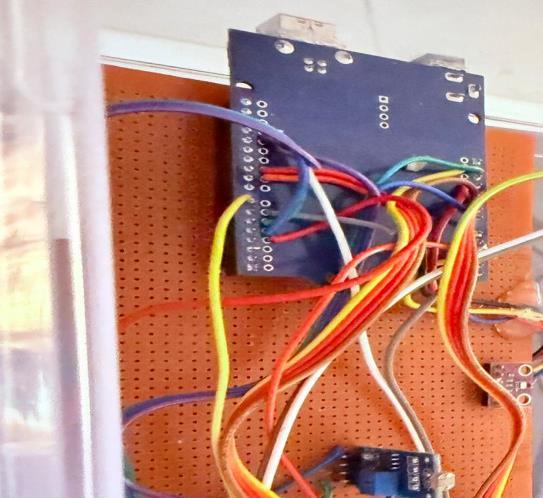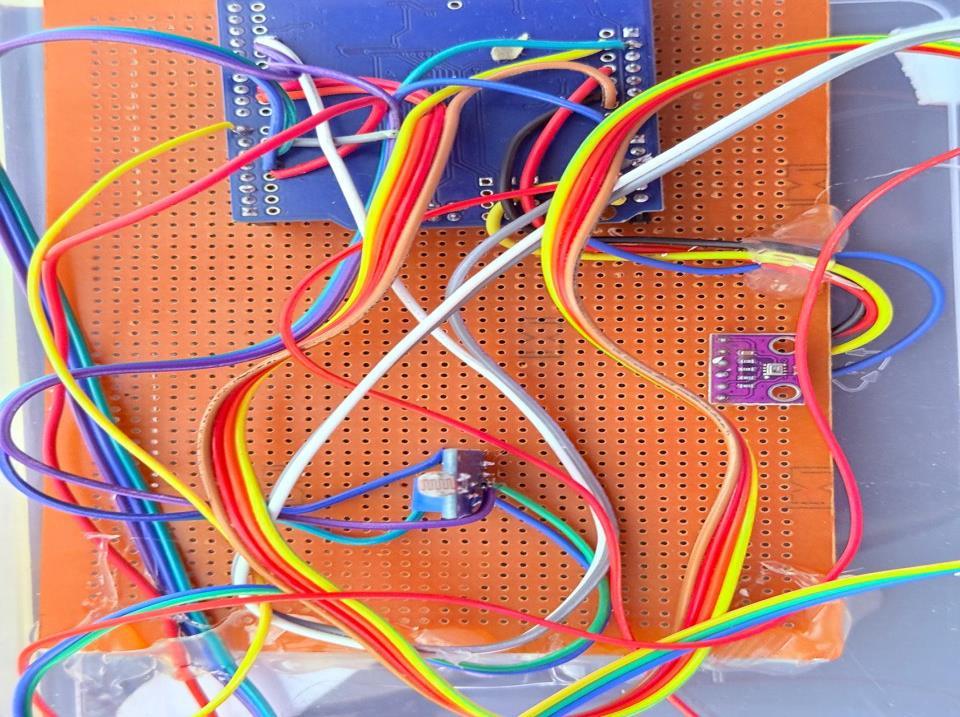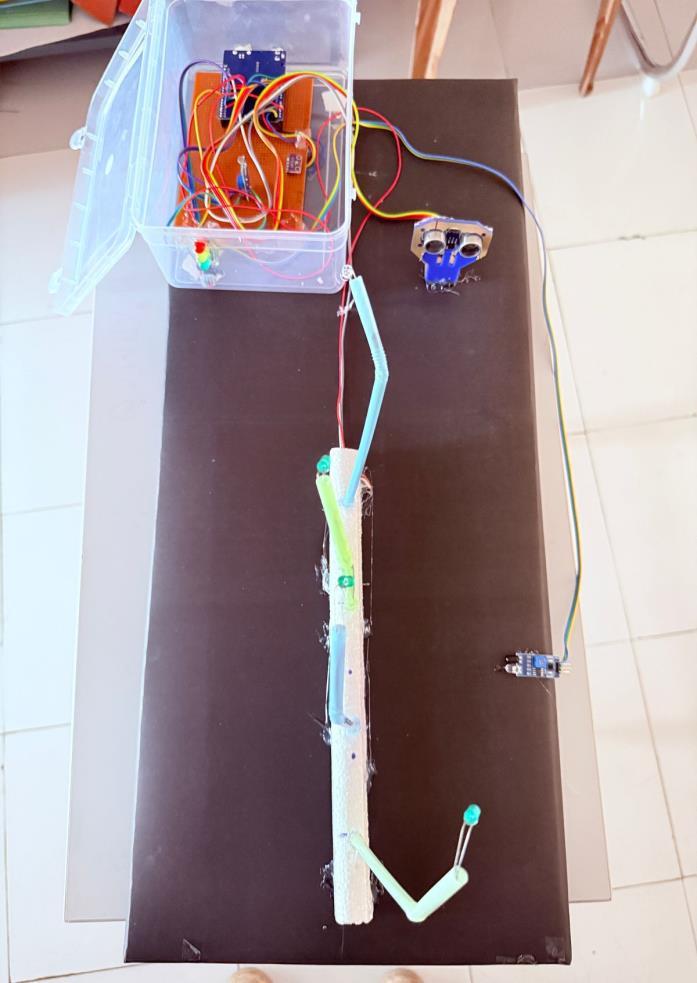
International Research Journal of Engineering and Technology (IRJET) e-ISSN: 2395-0056
Volume: 12 Issue: 04 | Apr 2025 www.irjet.net p-ISSN: 2395-0072


International Research Journal of Engineering and Technology (IRJET) e-ISSN: 2395-0056
Volume: 12 Issue: 04 | Apr 2025 www.irjet.net p-ISSN: 2395-0072
Professor1, Department of computer science and engineering, SRK Institute of Technology, NTR, Andhra Pradesh, India
Student2 , Department of computer science and engineering, SRK Institute of Technology, NTR, Andhra Pradesh, India
Abstract – The project proposes an intelligent IoT-based Smart Lighting system and U-turn motion detection to improve energy efficiency and road safety. An LDR sensor adjusts LED brightness based on ambient light, IR Sensors helps to detect the motion of the object in the field while ultrasonicsensorsdetectU-turnsandactivatealertLEDs.The system operates autonomously, reduces energy wastage, prevents accidents and improves motion detection accuracy.The design dynamically adjusts LED lighting to minimizeenergywastageandprovidestimelyalertsforU-turn movements, ensuring improved monitoring and safety. The system offers significant improvements over traditional models by reducing energy consumption and enhancing responsiveness.
Key Words: SmartLightingSystem,IoT,MotionDetection,Uturn Detection, Energy Efficiency, Ultrasonic Sensor, LDR Sensor, Smart City Infrastructure
1.INTRODUCTION
Thisresearchexploresthedevelopmentofasmartlighting system and U-Turn Motion Detection, a project that integratesvarioussensorinputstoenhanceautomationand safety in dynamic environments. The system leverages an LDR sensor to continuously monitor ambient light levels, ensuringthatlightingadjustmentsaremadeautomaticallyin response to changing environmental conditions. Furthermore, the design includes a component for U-turn detection using an ultrasonic sensor paired with LED indicators.Thisconfigurationisintended
J. P. Wen, S. J. Wang (2019), Energy-Efficient Smart Street LightingSystem[1]. Thisstudyfocusesonthedevelopmentof an intelligent street lighting system using sensor-based automation to optimize energy consumption. The system dynamicallyadjustslightingbasedonambientlightlevelsand trafficmovement,reducingunnecessarypowerusage.A.K. Prajapati, R. Sharma (2021), Adaptive Lighting System for Urban Environments [2]. Thisresearchpresentsanadaptive lightingmechanismthatutilizesLDRandweathersensorsto enhancelightingefficiency.Theproposedmodelintegrates environmental monitoring to improve energy savings and sustainability.M.T.Penella,M.Gasulla(2017), Smart Sensing
for Efficient Energy Management [3]. Thepaperexploresthe roleofsensor-basedsystemsinenergy-efficientapplications. Itdiscussestheintegrationofvarioussensors,includinglight andtemperaturesensors,toautomateenergymanagement insmartsystems.H.M.Kord,H.L.Chan(2020), A Review on Intelligent Motion Detection System [4]. This review paper analyses different motion detection methods, including ultrasonicandinfraredsensors,forimprovingsecurityand traffic management. The study highlights the limitations of conventionalsystemsandthebenefitsofintelligentsensor fusion. R. K. Gupta, P. Verma (2022), IoT-Enabled Smart Lighting and Motion Detection for Sustainable Cities [5]. This study integrates IoT-based automation with real-time data monitoringtodevelopasmartlightingandmotiondetection system. The system focuses on optimizing lighting while detectingspecificmovementpatterns,ensuringbetterenergy efficiencyandsafety.
Thecollecteddatafromthesensorsissenttothecloud,and thus the lighting system can be remotely controlled and monitoredinreal-time.Usingthisplatform,itispossibleto measuretrafficuseandenergyusagesothatinfrastructural planningcanbeaimedatreducingoperationalcosts.Onthe otherhand,itisanticipatedthatIoTtechnologywillhelpin energy-savings preservation and improve the safety of highwayusersbyprovidingappropriatelightconditions
• IRSensor
• Microcontroller-ArduinoorESP32/ESP8266
• PIR(passiveInfrared)motionsenor
• LightSource–LEDs
• Ambient Light Sensor – LDR (Light Dependent Resistor)
• DimmingFeature
U-turnmotiondetectionin Ghat section roads isacrucial applicationofadvancedtrafficmonitoringsystemsaimedat improvingroadsafetyandtrafficmanagement.Ghatroads, characterizedbywindingcurves,steepinclines,andsharp turns, often pose significant challenges for drivers due to reducedvisibilityandhigheraccidentrisk.

International Research Journal of Engineering and Technology (IRJET) e-ISSN: 2395-0056
Volume: 12 Issue: 04 | Apr 2025 www.irjet.net p-ISSN: 2395-0072
Insuchareas,detectingU-turnsisespeciallyimportant as they can create dangerous situations by interrupting the flowoftrafficorevencausingcollisions.Byimplementing motion detection technology in these regions, sensors strategically placed along the roads can monitor vehicle movement,identifyingsuddenorunauthorizedU-turns.
IRSensor
Microcontroller-ArduinoorESP32/ESP8266
PIR(passiveInfrared)motionsenor
LightSource–LEDs
5.Objectives
o To develop a system that automatically adjusts lighting based on the surrounding light intensity usinganLDRsensor.
o Toensureefficientenergyconsumptionbyreducing unnecessary powerusage when sufficient natural lightisavailable.
o To integrate a weather sensor and a temperature humidity sensor for monitoring environmental conditionsandenhancingsystemadaptability.
o To implement a U-turn motion detection mechanismusinganultrasonic-basedapproachto identifyvehicleorobjectmovementpatterns.
o To provide real-time visual alerts through LED indicators when a U-turn is detected, improving safetyinroadorrestrictedareas.
o To incorporate a buzzer system for immediate audible warnings, ensuring quick attention and responsetodetectedmovements.
o To create a system that operates autonomously without manual intervention, improving convenienceandefficiency.
o Toenhancesafetybyalertingindividualsorvehicles aboutpotentialobstructionsormovementsinthe surroundingenvironment.
o Todesignascalableandadaptablesystemthatcan be used in various applications, including street lighting,parkingareas,andrestrictedzones.
o Tooptimizetheintegrationofmultiplesensorsfor improved automation and real-time decisionmaking.
Current lighting systems mostly rely on manual or timebased controls, resulting in energy wastage and limited adaptability to environmental conditions. They lack intelligentsensorintegrationforreal-timeadjustmentsand failtodetectspecificmotionbehaviourslikeU-turns,which canleadtoinefficientenergyusageandcompromisedsafety.
7.1
The proposed system is designed to overcome the limitationsofexistinglightingandmotiondetectionsystems by integrating intelligent automation with real-time monitoring.Itcombinesautomaticlightingcontrolbasedon environmental conditions, ensuring efficient energy utilizationandenhancedsafety.Thesystemutilizesvarious sensors to provide precise data for decision-making, reducing energy wastage and improving situational awareness.
Oneofthemajorbenefitsoftheproposedsystemisitsability to optimize energy consumption. By using sensor-based lighting adjustments, the system ensures that artificial lighting is used efficiently and only when necessary. This helps in reducing electricity costs and promoting sustainability. The real-time adaptability of the system preventsunnecessaryenergywastageandcontributestoa moreeco-friendlyandcost-effectivesolution.
ThesystemisdesignedtodetectU-turnmovementsusingan ultrasonic-based approach, providing enhanced safety in roads,parkinglots,andrestrictedareas.Unlikeconventional motion detection systems that rely on general movement recognition,thissystemspecificallyfocusesonidentifyingUturnactions,ensuringmoreprecisemonitoring.Theability todifferentiatebetweennormalmovementandspecificUturn behavior allows for improved traffic management situationalawareness.
To enhance safety, the system provides real-time alerts through LED indicators when a U-turn is detected. This immediate response mechanism ensures that necessary precautions can be taken instantly, reducing the risk of accidentsandunauthorizedmovements.Thecombinationof visual and audible alerts ensures that warnings are easily noticeable,makingthesystemhighlyeffectiveinhigh-traffic areasandsensitivelocations.
7.5
Theproposedsystemisdesignedtooperateautonomously, eliminating the need for manual intervention. The integration of multiple sensors ensures that the system functionsinaself-sufficientmanner,reducingmaintenance effortsandoperationalcomplexity.Theautomationofboth lighting control and motion detection makes the system moreefficient,reliable,anduser-friendly.
7.6
Thesystemishighlyversatileandcanbedeployedinvarious environments, including streets, parking areas, industrial

International Research Journal of Engineering and Technology (IRJET) e-ISSN: 2395-0056
Volume: 12 Issue: 04 | Apr 2025 www.irjet.net p-ISSN: 2395-0072
zones,andresidentialpremises.Itsmodulardesignallows for easy scalability, enabling additional sensors and functionalities to be integrated as needed. This flexibility ensures that the system can be adapted to different requirements,makingitapracticalsolutionforbothsmallscaleandlarge-scaleimplementations.
Bycombiningsmartlightingcontrolwithmotiondetection, the system not only optimizes energy usage but also improvessafetyandsecurity.TheabilitytodetectU-turns andprovidereal-timealertsensuresbettertrafficregulation and reduces the likelihood of unauthorized or hazardous movements. Additionally, the automated lighting system enhances visibility in low-light conditions, further contributingtooverallsafety.
8.1 Sensor Integration: LDRforlightintensity,ultrasonic for distance-based motion detection, and IR sensors for objectdetection.
8.2 Hardware Design: Includesmicrocontroller,LEDs,and sensorsconnectedinafeedback-controlledsystem.
8.3 Software Logic: Embeddedprogrammingenablesrealtimesensordataprocessingandautomatedresponses.
8.4 Real-time Monitoring: The system processes sensor inputtocontrolLEDbrightnessanddetectU-turnmotions, activatingalertsasneeded.
The performance of the proposed system was validated through a series of real-time simulations and test cases, whichweredesignedtoexaminebothlightingefficiencyand motiondetectionaccuracy.
Lighting Efficiency: The system demonstrated a significant reduction in energy consumption, activating LEDs only under low ambient light conditions. Energy savings were consistently observedacrossalltestscenarios.
MotionDetectionAccuracy:Theultrasonicsensor preciselyidentifiedU-turnswithoutgeneratingfalse positivesforstraight-linemovements.TheIRsensor reliably detected nearby obstacles, enabling realtimeilluminationcontrol.
Response Time: The system exhibited quick responsivenesstochangesinambientlightingand objectmotion,withanaveragereactiontimeofless thanonesecond.
System Stability: Under varying environmental conditions (e.g., light intensity, temperature, and
humidity),thesystemmaintainedstableoperation withoutperformancedegradation.
Scalability Test: The modular design allowed for additional sensors and lighting nodes to be integratedwithoutalteringtheexistingframework, provingthesystem’sscalability.
Overall, the results confirm that the smart lighting and Uturn detection system is highly efficient, accurate, and adaptablefordeploymentinreal-worldurbanenvironments.



International Research Journal of Engineering and Technology (IRJET) e-ISSN: 2395-0056
Volume: 12 Issue: 04 | Apr 2025 www.irjet.net p-ISSN: 2395-0072

Testscenariosdemonstratethesystem’sresponsiveness toambientlightandmotion:
Inlowlight,LEDsactivateautomatically.
BrightlightpreventsunnecessaryLEDusage.
U-turnmovementstriggeralertsaccurately. Test
The proposed IoT-based Smart Lighting and U-Turn Detection System provides a cost-effective, automated solutionforenergymanagementandroadsafety.Byusing real-timesensordata,thesystemoptimizeslightingcontrol andidentifiesspecificmotionpatternssuchasU-turns.Its autonomous operation reduces manual workload and enhances reliability. Future enhancements may include remote control, data analytics, and wider deployment in smartcityapplications.Theuseoflow-powercomponents ensures sustainability, while the flexibility of deployment enablesitsuseinvariedscenarioslikeresidentialcomplexes, public roadways, parking facilities, and industrial zones. Furthermore, this solution contributes to environmental conservationeffortsbypromotingenergy-efficientpractices, aligningwiththeglobalgoalsforsustainabledevelopment.
[1]J.P.WenandS.J.Wang,"AnEnergy-EfficientSmartStreet Lighting System with Adaptive Control based on Environment," presented at the 2019 International ConferenceonArtificial IntelligenceandData Engineering (AIDE),2019.
[2] A. K. Prajapati and R. Sharma, "Adaptive Illumination: Designing a Smart Street Lighting System for Sustainable UrbanEnvironments,"2021.
[3] M. T. Penella and M. Gasulla, "Energy-Management for PowerAwarePortableSensorSystems,"2017.
[4] H. M. Kord and H. L. Chan, "A Review on Intelligent MotionDetectionSystems,"2020.
[5]R.K.GuptaandP.Verma,"IoT-EnabledSmartLighting andMotionDetectionforSustainableCities,"2022.